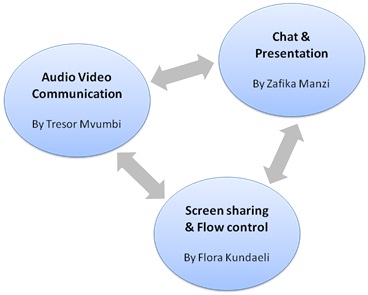
|
The project is based on the fact that most internet video conferencing solutions do not work well with low bandwidth and unstable internet connections as they were designed with the assumption of stable Internet connections with large amounts of bandwidth. Therefore countries like South Africa and other developing countries that experience connectivity problems are unable to use these solutions. The main research questions addressed by the project are:
In order to respond to the research questions, an experimental prototype was developed. It was first assumed that the underlying Internet connection is low bandwidth and unstable. This assumption motivated core system design choices, which focused on delivering an acceptable and satisfactory user experience. The resulting system has 3 modules, developed by 3 group members. The figure illustrates the global system overview.  Audio and Video The audio module aims to provide a clear sound stream conveying an intelligible speech when using the smallest bandwidth possible. The video module complements audio and enhances the sense of presence by allowing participants to see each others during the meeting. When the bandwidth becomes insufficient, the audio stream is prioritized. Chat and presentation The chat module has the highest priority; to allow participant to exchange text messages when all the multimedia streams cannot work due to insufficient bandwidth. The presentation module provides slide sharing between participants. The presentations are pre-loaded unto participants’ PCs, only the ID of the current page is exchanged during the meeting. Slides are compressed before being sent across the network. Participant list and desktop sharing The system will track the list of participants in the meeting and manage floor control. The desktop sharing allows clients to remotely share their computer’s desktops. |
Hussein Suleman
Antoine Bagula |